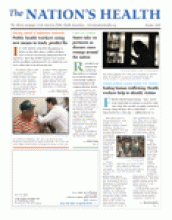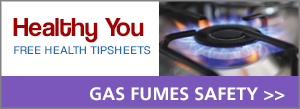Fresh from Eastern Europe, “Anna” arrived in the United States in response to an ad for a mail-order bride. But soon after accepting a proposal of marriage, things fell apart. Her so-called fiancé — a U.S. citizen involved in a crime ring — trafficked her for sex.
After three years of forced prostitution, Anna sought services at a domestic violence shelter in Illinois. Thanks to a shelter employee who had recently participated in a training program aimed at identifying and helping victims of human trafficking, the young woman was brought to safety.

After being trafficked into a blue jeans sweatshop in Thailand where she worked for no pay and received little food, this woman escaped to a government-run shelter in 2005.
Photo by Kay Chernush, courtesy U.S. State Department
A year later, Anna — not her real name — remains safe, but the global battle against human trafficking continues. According to the U.S. Department of Homeland Security, hundreds of thousands of adults and children are trafficked each year across borders around the world, including the United States. Some of the victims are lured from their homes with promises of jobs in more prosperous countries. Many arrive at their destinations to have their identifying documents confiscated by traffickers who tell them their families back home will be harmed if they try to escape.

Before they were rescued in 2005, these children in India were forced to work on carpet and sari looms from morning to night.
Photo by Kay Chernush, courtesy U.S. State Department
After drug dealing, human trafficking is tied with arms dealing as the second-largest criminal industry in the world, according to the U.S. Department of Health and Human Services. And with profits totaling about $32 billion yearly, it is the fastest growing.
In the decade since the United States enacted its Trafficking Victims Protection Act and the global community adopted its own standards, 116 countries have enacted legislation to prohibit human trafficking, defined as a form of slavery in which victims are subjected to force, fraud or coercion for the purpose of sexual exploitation or forced labor. Traffickers typically keep victims out of public view and instill fear in them to keep them enslaved.
More than 12 million people are working in forced or bonded labor and forced prostitution around the globe, according to a report released in June by the U.S. Department of State.
“This human rights abuse is universal, and no one should claim immunity from its reach or from the responsibility to confront it,” said Secretary of State Hillary Rodham Clinton while announcing the release of the agency’s 10th annual “Tracking in Persons Report,” which outlines the continuing challenges posed by human trafficking across the globe. “Ending this global scourge is an important policy priority for the United States. This fluid phenomenon continues to affect cultures, communities and countries spanning the globe.”

Children protest in New Delhi, India, on the Global Day Against Trafficking in December 2008. More than 12 million people — including children — are working in forced or bonded labor and forced prostitution around the globe, according to the U.S. Department of State.
Photo by Raveedran, courtesy AFP/Getty Images
The report ranks 177 countries on their efforts to comply with the minimum standards set forth by the U.S. Trafficking Victims Protection Act. The report gave the lowest marks to 13 countries, including Cuba, North Korea, Saudi Arabia and Zimbabwe. The report also ranks those in full compliance with the standards, such as Austria, Ireland, Italy, South Korea, Spain and Sweden — as well as the United States, which has created federal programs specifically to address the issue.
Trafficking in America: The battle at home
In the United States, cases of human trafficking have been reported in all 50 states and the District of Columbia. The State Department estimates that between 14,500 and 17,500 foreign nationals are trafficked into the United States each year, but the scope of the problem is difficult to measure because of the invisibility of the victims and high levels of under-reporting.
Trafficking occurs in a range of occupations and settings in the United States, but victims are not always easily identifiable. Victims who are U.S. citizens are most commonly involved in the sex trade, while the majority of foreign victims in the United States are in labor trafficking, toiling as maids, health aides, salon workers, construction workers, farm hands and other laborers.
Fortunately, there are programs at both the federal and state level working to identify and aid human trafficking victims. In Illinois, Anna was brought to safety because an alert shelter worker learned how to identify victims through a training program offered by the Illinois Department of Human Services. Health and social service workers are well-situated to tackle the issue, as victims often take advantage of their services, seeking help for sexually transmitted diseases, pregnancy or injuries. In fact, 28 percent of human trafficking victims report having had contact with the health care system while in a trafficking situation, according to the Family Violence Prevention Fund.
For workers at Illinois Rescue and Restore, acting on that contact is important. Launched in 2005 in partnership with the U.S. Department of Health and Human Services, the program provides free training and has brought about 15 trafficking victims to safety. The initiative works to raise awareness of the problem, which can be missed by health professionals.
“Every time we go out to do a training, there is someone who says ‘I never heard of this before,’ or ‘This doesn’t happen in my neighborhood,’ or ‘This doesn’t happen in Illinois,’ or ‘This doesn’t happen on my block,’” Caronina Grimble, MPP, MA, senior project manager for the Illinois program, told The Nation’s Health. “And while they might be right, that it is not happening on their block, it certainly could happen, because we have seen incidences of human trafficking in every type of community — urban, rural, suburban, affluent, low income, middle income — it is everywhere.”
The Illinois program is making inroads. Recognizing that victims and their traffickers could walk through the door of his clinic at any moment, Don Hunt, director of adult and laboratory services at the Sangamon County Department of Public Health in Springfield, Ill., recently invited Grimble’s staff to Springfield to conduct a training session.
“We keep our eyes open to battered women, women involved in dating violence, people that are being manipulated because they might be weaker than someone mentally or physically,” Hunt said. “Those are things we look for and refer people on for help, so why not human trafficking also?”
Similar efforts are under way in other states, such as Colorado. Last year, the Colorado Network to End Human Trafficking, a statewide coalition of service providers, partnered with Polaris Project Colorado to sponsor a two-day “train-the-trainer” institute on human trafficking for health care providers. Fueling the first-of-its kind event was a realization that few health care providers realize that they play front-line roles. But Philip Gazley, a longtime anti-trafficking activist who helped organize the event, said he sees the landscape shifting.

Children in Northern Thailand in 2005 play at a day school where U.S. funding helps protect girls at risk of trafficking.
Photo by Kay Chernush, courtesy U.S. State Department
“These are still early days in the movement,” Gazley told The Nation’s Health. “Many people have compared where we are with human trafficking as being similar to where domestic violence was 25 to 30 years ago. I think we have reached a point as a movement where it is really the right time to engage health care professionals in this issue.”
At the federal level, the Department of Homeland Security launched its new Blue Campaign in July. Online at www.dhs.gov/humantrafficking, the campaign encompasses a wide range of anti-trafficking programs and public outreach tools.
Additionally, the Department of Health and Human Services, the designated federal agency responsible for helping U.S. victims of human trafficking receive benefits and services, operates the Rescue & Restore Victims of Human Trafficking campaign. Available online at www.acf.hhs.gov/trafficking, the campaign provides a toolkit aimed at helping health professionals increase the number of identified trafficking victims and to help those victims receive the benefits and services needed to live safely in the United States. The tools include the kinds of screening questions health care providers should consider when trying to determine if someone is a trafficking victim.
For more information on human trafficking, visit www.acf.hhs.gov/trafficking.
Footnotes
Human trafficking will be the subject of several sessions at APHA’s 138th Annual Meeting in Denver in November. For information, visit www.apha.org/meetings.
- Copyright The Nation’s Health, American Public Health Association









